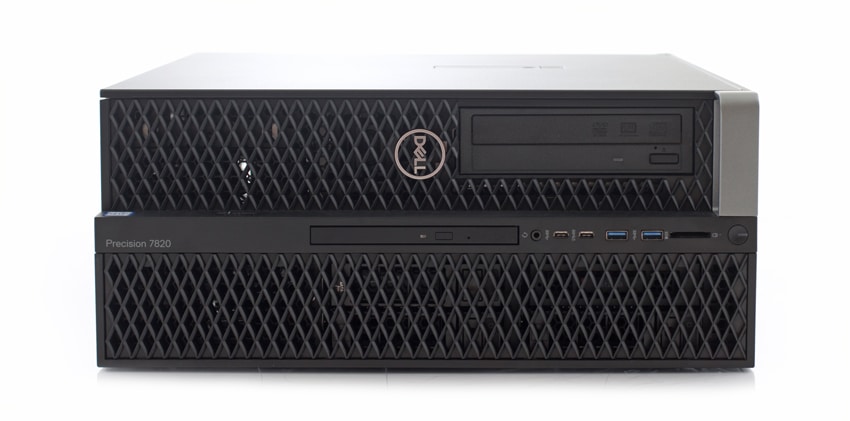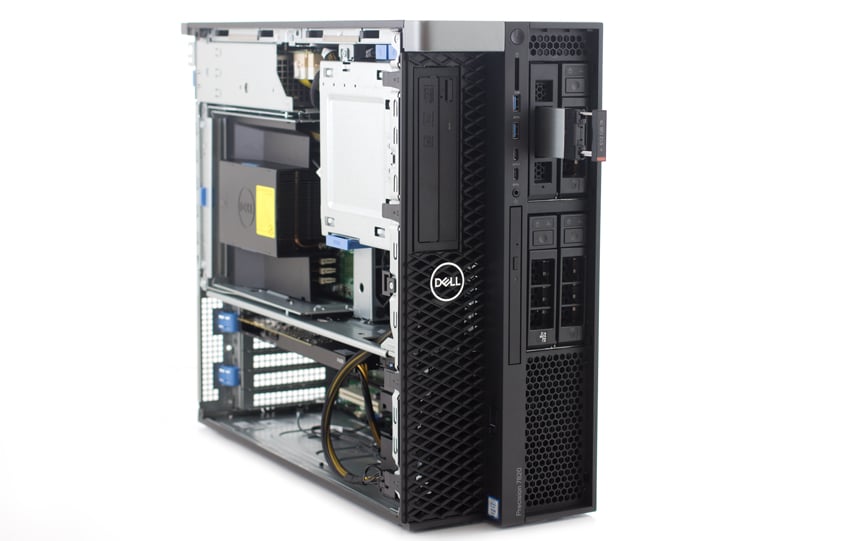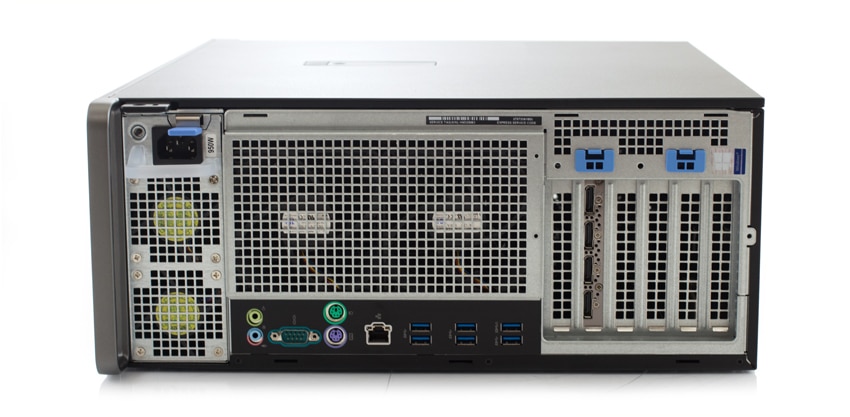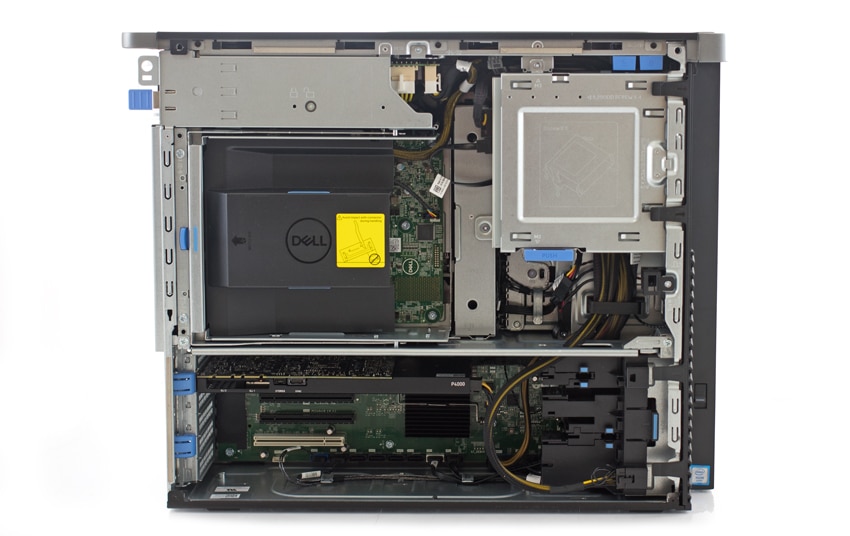 The Dell Precision 7820 Tower (T7820) is a powerful workstation designed to handle data-intensive workloads, delivering dual-socket performance through Intel’s current gen Xeon processor Scalable Family (up to 28 cores per processor). Though it uses a fairly compact design, the T7820 is a fully customizable workstation that can be scaled as your needs grow. For example, the T7820 can be outfitted with a massive 384GB of 2666MHz memory and up to 24TB in storage capacity.
The Dell Precision 7820 Tower (T7820) is a powerful workstation designed to handle data-intensive workloads, delivering dual-socket performance through Intel’s current gen Xeon processor Scalable Family (up to 28 cores per processor). Though it uses a fairly compact design, the T7820 is a fully customizable workstation that can be scaled as your needs grow. For example, the T7820 can be outfitted with a massive 384GB of 2666MHz memory and up to 24TB in storage capacity.
The Dell Precision 7820 Tower is a powerful workstation designed to handle data-intensive workloads, delivering dual-socket performance through Intel’s current gen Xeon processor Scalable Family (up to 28 cores per processor). Though it uses a fairly compact design, the T7820 is a fully-customizable workstation that can be scaled as your needs grow. For example, the T7820 can be outfitted with a massive 384GB of 2666MHz memory and up to 24TB in storage capacity.

The T7820 also features next-generation AMD Radeon Pro and NVIDIA Quadro professional graphics options, making it a capable workstation for 3D rendering and other graphics-intensive tasks. High-end options include the NVIDIA Quadro GP100, NVIDIA Quadro P6000, and Radeon Pro WX 9100 cards, while mid-range and entry cards include the NVIDIA Quadro P4000 and Radeon Pro WX 3100, respectively. There’s a lot more to choose from than those options depending on your specific use case.
The Dell Precision 7820 Tower was also designed specifically for professional software applications. Using the Dell Precision Optimizer program, users can gain increased application performance and productivity from their Dell Precision workstation by automatically adjusting system settings based on the needs of specific professional software applications.
Our particular build for this review includes:
- NVIDIA Quadro P4000
- 96GB of DDR3 memory
- Dual Intel Xeon Gold 6148 CPU (2.40GHz)
- Samsung SM961 NVMe M.2 drive.
Dell Precision 7820 Tower Specifications
| Processor options |
One or two Intel Xeon processor Scalable family CPUs with up to 28 cores per processor and Intel Advanced Vector Extensions, Intel Trusted Execution Technology, Intel AES New instructions, Optimized Intel Turbo Boost and optional Intel vPro™ technology |
| Operating system options | Windows 10 Pro for Workstations (up to 4 Cores) |
| Windows 10 Pro for Workstations (4 Cores Plus) | |
| Windows 10 Pro for Workstations Downgrade to Windows 7 (up to 4 Cores) | |
| Windows 10 Pro for Workstations Downgrade to Windows 7 (4 Cores Plus) | |
| Red Hat Enterprise Linux 7.3 | |
| Ubuntu Linux 16.04 | |
| Suse Linux (SLES 12 SP2) supported | |
| NeoKylin 6.0 SP3 (China only) | |
| Memory options |
Six channel memory up to 384GB 2666MHz DDR4 ECC memory with dual CPUs, 12 DIMM Slots (6 DIMMs per CPU). |
| Chipset | Intel C621 (Lewisburg) |
| Graphics options |
Support for 2 PCI Express x16 Gen 3 graphics cards – up to 500W with maximum of 2 x 250W double-width graphics cards on single CPU configurations. Up to 2 x 150W single width graphics cards on dual CPU configurations. |
|
High end 3D cards: Radeon Pro WX 9100 |
|
|
Mid-range 3D cards: Radeon Pro WX 7100 |
|
|
Entry 3D cards: Radeon Pro WX 3100 |
|
|
Professional 2D cards: NVIDIA NVS 310 |
|
| Storage options |
Front accessible FlexBays support up to 4 x 2.5”/3.5” SATA HDD/SSDs and up to 6 x 2.5” and 5 x 3.5” drives with 5.25” bay populated. |
|
Up to 2 front accessible (hot plug) M.2 NVMe PCIe SSDs are supported in FlexBays on enabled PCIe chassis with integrated Intel controller. |
|
|
NVMe RAID 0,1 option (Intel RSTe vROC). Dell M.2 carrier with PCIe SSD for PCIe FlexBay available as customer kit. |
|
|
Up to 4 x M.2 NVMe PCIe SSDs via 1 x Dell Ultra-Speed Drive Quad x16 card. NVMe RAID 0,1,10 option (Intel RSTe vROC). |
|
|
M.2 NVMe PCIe SSDs: Up to 4 x 1TB drives on 1 Dell Precision Ultra-Speed Drive Quad x16 cards. |
|
|
Front FlexBay M.2 NVMe PCIe SSDs: Up to 2 x 1TB drives |
|
|
2.5” SATA SSD: Up to 6 x 1TB drives |
|
|
3.5” SAS 7200 RPM 12Gb/s: Up to 5 x 4TB |
|
|
2.5” SAS 10K RPM 12Gb/s: Up to 6 x 1.8TB |
|
|
2.5” Self Encrypting Drives: 512GB 2.5” SED (OPAL/ FIPS (140-2) HDD |
|
|
M.2 PCIe SED SSD: 512GB and 1TB |
|
| Dimensions | Height: 417.9 mm (16.45”) X Width: 176.5 mm (6.95”) X Depth: 518.3 mm (20.41”). Optional 19” rackmount rail kit. Starting weight: 15.9kg (35.1 lb) |
| Security | Trusted Platform Module (TPM 2.0); Optional CAC/PIV card reader for slimline bay, chassis Intrusion switch; Setup/BIOS Password; I/O Interface Security; Kensington lock slot, Padlock ring, lockable power supply; Optional hard drive locking sleds (key lock), Dell Data Guardian, Dell Endpoint Security Suite Enterprise |
| Ports | Front 2 USB 3.1 Type A 2 USB 3.1 Type C 1 Universal Audio Jack Up to 2 (future 4) PCIe slots in PCIe enabled chassis for M.2 and U.2 (future) PCIe SSDs |
| Internal 1 USB 2.0 1 USB 2.0 header. (requires 3rd party splitter cable to support 2 USB 2.0 Type A ports) 8 SATA @6Gb/s plus 1 SATA for optical |
|
| Rear 6 USB 3.1 Type A 1 Serial 1 RJ45 Network 2 PS2 1 Audio Line out 1 Audio Line in/Microphone |
|
| Slots | All slots PCIe Gen 3 2 PCIe x16 1 PCIe x16 wired as x8 1 PCie x16 wired as x4 1 PCIe x16 wired as x1 1 PCI 32/33 |
| Chassis | Bays: (2) FlexBays and (1) 5.25” FlexBay (can support 1 x 3.5” or 2 x 2.5” HDD/SSD drives as factory option or customer kit) (1) Slimline optical bay; (1) SD slot UHS ll Class 3 with read only support (SW enabled).Available PCIe chassis with PCIe FlexBays supporting M.2 NVMe PCIe SSDs and future U.2 NVMe PCIe SSDs. PCIe FlexBay customer kit available. |
| Regulatory | Energy Star configurations available including 80 PLUS registered Gold power supplies; EPEAT registered (see epeat.net for specific registration rating/status by country); China CECP; GS Mark. For a complete listing of declarations & certifications, see Dell’s regulatory & compliance homepage at dell.com/regulatory_compliance |
Design and Build
At roughly 16 inches tall and almost 7 inches wide, the 7820 is a fairly compact workstation for the amount of power it offers. It features two separate bezels that double as ventilation (i.e., HDD bezel and front bezels that can easily be removed), with all the front connectivity stacked vertically in the center. The 7820 is also outfitted with a useful handle at the top left, allowing for easy transportation.
For connectivity and functionality, the front panel features a Power button/light, a drive activity light, an SD card slot, 2x USB 3.0 ports, two USB 3.0 Type-C ports (one with PowerShare), a headset port, and an optical drive tray. The panel can be removed to easily access the drives. Dell also has a PCIe sled that allows for easy access/replacement of the M.2 drive.

On the rear panel of the 7820 are the microphone/line-in and line-out port, a serial port, PS/2 mouse and keyboard ports, network port, 6x USB 3.0 ports, discrete graphics card slot, and expansion card slots. The whole rear panel also acts as ventilation.

In our review unit, we equipped the Dell 7820 with the Quadro P4000, one NVIDIA’s powerful mid-range professional graphics cards. The P4000 is designed for demanding professional applications and features a 1792 CUDA core Pascal GPU, 8GB GDDR5 of memory and advanced display technologies with a very power-efficient 105W in maximum power consumption.
NVIDIA Quadro P4000 Specifications
- GPU Memory: 8GB GDDR5
- Memory Interface: 256-bit
- Memory Bandwidth: Up to 243 GB/s
- NVIDIA CUDA Cores: 1792
- System Interface: PCI Express 3.0 x16
- Max Power Consumption: 105 W
- Thermal Solution
- Active Form Factor: 4.4” H x 9.5” L, Single Slot, Full Height
- Display Connectors 4x DP 1.4
- Max Simultaneous Displays: 4 direct, 4 DP 1.4 Multi-Stream
- Display Resolution 4x 4096×2160 @ 120Hz 4x 5120×2880 @ 60Hz Graphics APIs Shader Model 5.1, OpenGL 4.54 , DirectX 12.05 , Vulkan 1.04
- Compute APIs: CUDA, DirectCompute, OpenCL
Performance
To test its performance, we put the Precision T7820 through a variety of benchmarks that gauge its ability to perform in resource-intensive scenarios and test how well the NVIDIA Quadro P4000 can perform inside Dell’s new tower workstation. We will be comparing the T7820 to the company’s 5720 All-in-One and Precision T7810.
This first benchmark was the SPECviewperf 12 benchmark–the worldwide standard for measuring graphics performance based on professional applications. SPECviewperf runs 9 benchmarks it calls “viewsets,” all of which represent graphics content and behavior from actual applications. These viewsets include 3D Max, CATIA, Creo, Energy, Maya, Medical, Showcase, Siemens NX, and Solidworks.
When outfitted with the Quadro P4000, the T7820 recorded some fairly impressive results, which was expected with a power-driven mobile graphics card like this. We also see a significant improvement on the previous T7810 model.
| SPECviewperf 12 | |||
|---|---|---|---|
| Viewsets | T7820 | 5720 | T7810 |
| 3dsmax-05 | 129.09 | N/A | N/A |
| catia-04 | 141.41 | 103.54 | 112.02 |
| creo-01 | 102.90 | 82.59 | 72.96 |
| energy-01 | 11.88 | 4.35 | 9.65 |
| maya-04 | 84.58 | 81.01 | 71.24 |
| medical-01 | 53.69 | 31.68 | 41.68 |
| showcase-01 | 80.73 | 62.30 | 58.68 |
| snx-02 | 152.65 | 102.55 | 112.32 |
| sw-03 | 125.17 | 108.05 | 123.50 |
We also ran SPECwpc, which is a benchmark designed specifically for testing all key aspects of workstation performance. SPECwpc consists of over 30 workloads that it uses to test CPU, graphics, I/O, and memory bandwidth. The workloads fall under broader categories (average of all the individual workloads in each category) and are comprised of media and entertainment, financial services, product development, energy, life sciences, and general operations. Here, the T7820 recorded extremely impressive results, clearly demonstrating the system’s ability to thrive in intensive workload:
| SPECwpc v2.0 | |||
|---|---|---|---|
| Category | T7820 | 5720 | T7810 |
| M&E | 5.12 | 2.57 | 2.28 |
| ProdDev | 6.45 | 2.42 | 4.9 |
| LifeSci | 10.66 | 2.51 | 6.12 |
| Energy | 8.51 | 2.27 | 7.6 |
| FSI | 24.52 | 1.32 | 5.02 |
| GeneralOps | 1.65 | 1.28 | 1.57 |
Using our ESRI benchmark, we looked at several aspects of the ArcGIS program. In cases like these, we are most interested in the average of the drawtime, average frames per second, and minimum frames per second. With drawtime, the T7820 recorded an average time of just 00:06.3430. Average FPS and minimum FPS showed impressive results again with 506.194 and 266.549, respectively.
| ESRI Benchmark | |
|---|---|
| Drawtime | Average |
| Precision T7820 | 00:06.3430 |
| Precision 5720 | 0:00:17.848 |
| Precision T7810 | 0:00:06.498 |
| Average FPS | Average |
| Precision T7820 | 506.194 |
| Precision 5720 | 132.018 |
| Precision T7810 | 368.473 |
| Minimum FPS | Average |
| Precision T7820 | 266.549 |
| Precision 5720 | 73.025 |
| Precision T7810 | 192.335 |
Conclusion
As demonstrated above, Dell’s Precision T7820 proved to be an impressive desktop workstation that has some pretty deep customization options, including a wide range of high-end AMD and NVIDIA graphics cards like the Quadro P4000. Users can also power up their T7820 workstation with two Intel Xeon processors (which feature up to 28 cores per processor), up to a massive 384GB 2666MHz of DDR4 ECC memory. Dell also offers a variety of drive configurations for a maximum of 24TB total storage, which includes M.2 NVMe PCIe SSDs via the 6 available PCIe Gen 3 slots. It also features the usual connectivity options such as USB 3.1 Type A and C, USB 2.0, and a spot for a SATA optical drive.
To find out what this workstation is capable of, we put the T7820 through three distinct graphics-intensive benchmarks (the SPECviewperf, SPECwpc, and ESRI tests) and compared it to the 5720 All-in-One and Precision T7810. We outfitted our build with higher-end components, including an NVIDIA Quadro P4000, 96GB of DDR3 memory, Intel Xeon Gold 6148 CPU (2.40GHz), and a Samsung SM961 NVMe M.2 drive. Looking at the graphics-intensive SPECviewperf test, the T7820 demonstrated impressive performance. In our SPECwpc benchmark (which gauges CPU, graphics, I/O, and memory bandwidth performance), the T7820 clearly demonstrated the system's ability to thrive under intensive workloads. In our ESRI test, we recorded an average drawtime of 00:06.3430, while average FPS and minimum FPS boasted an impressive 506.194 and 266.549, respectively.
The T7820 is a powerful desktop workstation. With its storage, compute and graphics performance, users can be assured that it will be able to handle most resource-intensive workloads with ease, especially when outfitted with even higher-end components than what we had. However, as is the case of all customizable workstations, this all depends on if you are willing to expand your budget, as the T7820 can get expensive fast.
The Bottom Line
The Dell Precision 7820 Tower is a powerful desktop workstation with a range of impressive options to suit the needs of most resource-intensive use cases.
Dell Precision 7820 Tower Product Page
Sign up for the StorageReview newsletter
